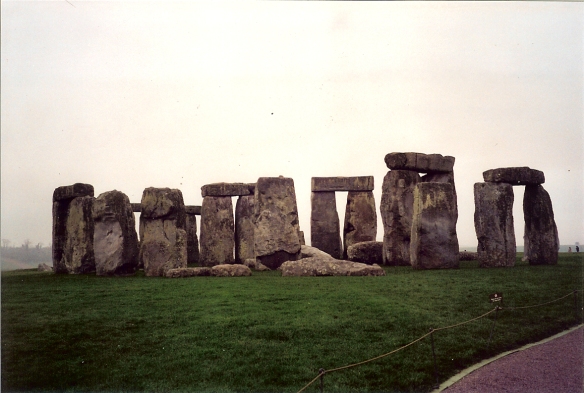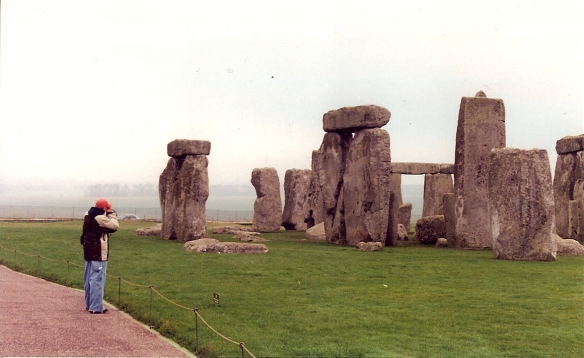Upon reading my post about our Stonehenge visit in December 2000, my friend Margaret commented, “Do I recall correctly that Stonehenge is now surrounded by fencing, so that you can’t wander among the stones?” and the answer to that is yes. But—as in the original post—it’s not as big as you think. 🙂
When we arrived at Stonehenge in December 2000, Anna was dismayed that we could no longer just walk among the stones—there was a fence. But fence is an all-purpose word here. I would say that Stonehenge—the stones themselves—was roped off. Sort of like the roped-off line you stand in to pass through security at the airport. Only knee height.
Signs seemed to apologize for this development, but apparently people (stupid, stupid people) were chipping pieces off the rocks. It had to be stopped. Thus the fence.
(sigh)
Anyway, I did a little research. Is there a bigger fence at Stonehenge now, thirteen years later? The short answer is no, the current fence is still the same. You can see it in this short video, which has more than one story to tell.
(sigh, again *)
There is a much larger fence that surrounds the roughly thirty acres that comprise the entire site.
However, as I researched I found so much interesting information I decided to share it with you.
When Jesse and I were there in 2000, you could drive right by Stonehenge on a busy freeway (the entire site is fenced with chainlink). It was startling to approach from afar and see this thing that had loomed in my imagination since childhood. OMG, OMG, OMG! There it is! I think it must be sort of how some people react when they find themselves close to a country music star in Nashville. (I’ve observed this phenomenon, actually, up close, often. What does it say about me that I could care less about Garth Brooks but feel faint when I see five-thousand-year-old rocks?)
English Heritage—officially the Historic Building and Monuments Commission for England, the entitity that manages this site and others—is working on changing that.
What is it with those two busy roads rumbling within a few metres of the stones? … Few will argue against the key concept of making it possible to walk to the stones from the landscape without risking collision with a juggernaut. The removal of stock fences and ugly security barriers is also bound to be welcomed by just about everyone.
English Heritage will be limiting the number of people who can arrive by car or coach via its planned new visitor facilities. In the future, tourists will have to book to be sure of a place in the car park and on the shuttles that will ferry them to the stones. A visit to England’s greatest prehistoric site will take a little bit of thinking ahead.
Oh, I can only imagine how controversial it will be. (Read about the plans here. And read about what others are saying about them here. Personally I think the idea of ripping up a highway and covering it with grass is freaking brilliant.) Witness all the whining I did about the things that had changed on my last visit to Ireland, most notably the Cliffs of Moher. But it turns out the Neolithic folk who built Stonehenge wanted it fenced off from the riff-raff too.
Tourists who complain about the fence put up around Stonehenge in the Seventies should spare a thought for their Neolithic ancestors… they couldn’t even see the site because of a huge wooden barrier.
Archaeologists have found traces of the 20ft-high timber fence that snaked almost two miles across Salisbury Plain and hid sacred ceremonies from unworthy locals more than 5,000 years ago.
Read about that here. They believe it was nothing more than a way to hide religious ceremonies from prying eyes—that is, kept the “lower classes” from seeing the activities of the “priestly classes.” Wow. Human nature, eh?
There’s even more of a reason for that, though. Archeologists now think Stonehenge may have been a burial site for, you know, the elite of the Neolithic classes. 🙂
The first bluestones, the smaller standing stones, were brought from Wales and placed as grave markers around 3,000BC, and it remained a giant circular graveyard for at least 200 years, with sporadic burials after that, he claims.:)
But wait, we were talking about fences, right? And keeping people out of Stonehenge. Here’s the thing: you can get up close and personal with the stones. There are two ways:
• Stonehenge Stone Circle Access (approx. double the regular fee)
• Summer Solstice at Stonehenge (free)
The Stone Circle Access looks interesting:
Stone Circle Access visits take place outside the normal opening times at Stonehenge, and are very early in the morning or late in the evening, and are not offered during the normal opening times. The visit must be pre-booked and paid for in advance of your visit by completing the Stone Circle Access application. Each visit lasts for one hour, and we allow only a maximum of 26 people within the stones.
If I were going back, I believe I would do this. (I will say that there were probably fewer than twenty-six people there the very cold, very windy day we visited in December 2000.) The current posted cost is £16.30, which is just over $25. Sunrise at Stonehenge? Oh yeah.
The other option is a “managed open access” at the summer solstice:
English Heritage are again expected to provide “Managed Open Access” for around 20,000 people to Stonehenge for the Summer Solstice. Please help to create a peaceful occasion by taking personal responsibility and following the conditions. Access to the stones themselves is expected to be from around 7pm on Thursday 20th June until 8am on Friday 21st June.
I think this is really special—it’s free, and it acknowledges the stones are still a place of spiritual pilgrimage for some. Twenty thousand people are more than I want to share this experience with, but check out the site and scroll down for the photo.
So, Virginia, you can see the stones without a fence between. 🙂
As a parting shot, here are a couple of blog posts from other travelers. You can imagine my true thoughts, I think. This one is from one of those folks who should be denied a passport because she makes Americans look, well, shallow:
Tour guide Steve said we’d stop 30 minutes for Stonehenge. I thought that was crazy short. Turned out he was right. There’s a fence around it and something like a $30 admission charge, but you can stand outside the outer fence and get a decent photo. It’s in the middle of nowhere. I know it’s impressive they built this thing, but overall, it’s a five-minute look and you’re on the road again.
I’ve included Steve’s blog in my blogroll because he has lots of interesting things to say about his area of expertise, which is Washington DC. (And he didn’t write this particular post.) Furthermore, I fully recognize that choices must be made when traveling (my first choice: don’t “do” England in eight days) but this makes me want to scream. Stand outside and get a decent photo? What’s the point of being there at all? And Steve should do his homework on the admission fee; currently it’s eight pounds sterling, which is just over twelve dollars and that’s a far cry from thirty. (Do have a look at that photo, though, and the line of humans waiting to see the stones. This is precisely why I like traveling in the off-season.)
This post amused me because the writer mentions what I noted in my original Stonehenge post: the stones are not as big as we tourists imagine them to be. Still, my reaction was not this:
I’ve just always assumed Stonehenge to be HUGE and towering and imposing and awe-inspiring. Just like all classic desktop wallpapers and photos that we see of it everywhere … but it turned out to be waaaay smaller … In reality, it was disappointingly only about twice the height of an average man’s height.
Visitors are not even allowed get close to the rocks—they are roped off from the general public, a good 10 metres or so away. Only people who sign up for those expensive exclusive sunrise or sunset tours—ranging from £79 to £92 per person (adult price)—get to go inside the inner circle and see the rocks up close.
I don’t know where she gets her information on the tours. I’ve already mentioned it’s about $25 for an adult, which is nowhere close to what she quotes here—but it may be some sort of private tour by a third-party entity. However, the photos are good and she mentions both fences, too, which is a great place to end this post.
Is Stonehenge fenced? Yes! But it’s all good.
* I don’t care that these boys did this. I’m all for breaking silly rules. However, this is a UNESCO World Heritage Site (since 1986) that attracts approximately 900,000 visitors every year. Someone could break an ankle, for heaven’s sake.
UPDATE: I found one more photo when I was flipping through the scrapbook. This one shows everything we were discussing about SIZE and FENCES in one shot.
First, it’s the sole photograph I took that shows human scale. (I was trying to take photos without people in them. I’ve since changed this policy.) Those bluestones (the ones that formed the outer circle, the ones that had the lintel stones laying across the top) are only about ten feet tall. (The sarsen stones in the center are taller.)
You can also clearly see the little rope fence, about knee-high. It’s not physically stopping anybody. If you were quick, you could be over that thing to photo-bomb some tourist’s pretty picture before anyone could stop you.
Now look beyond the stones. See the chain-link fence? See the car? (Hint: look right where the man is holding up his camera. There’s the car.) It’s traveling on the A344, which you can read about here.


